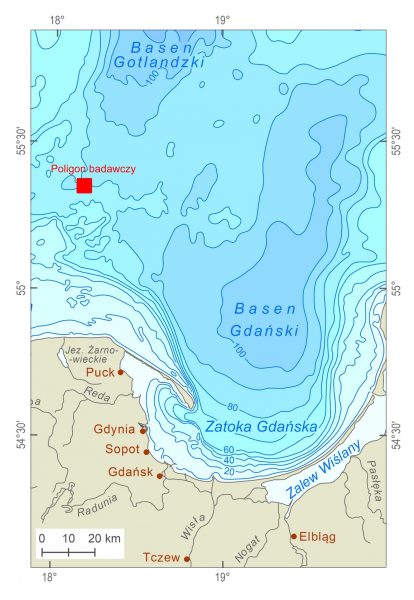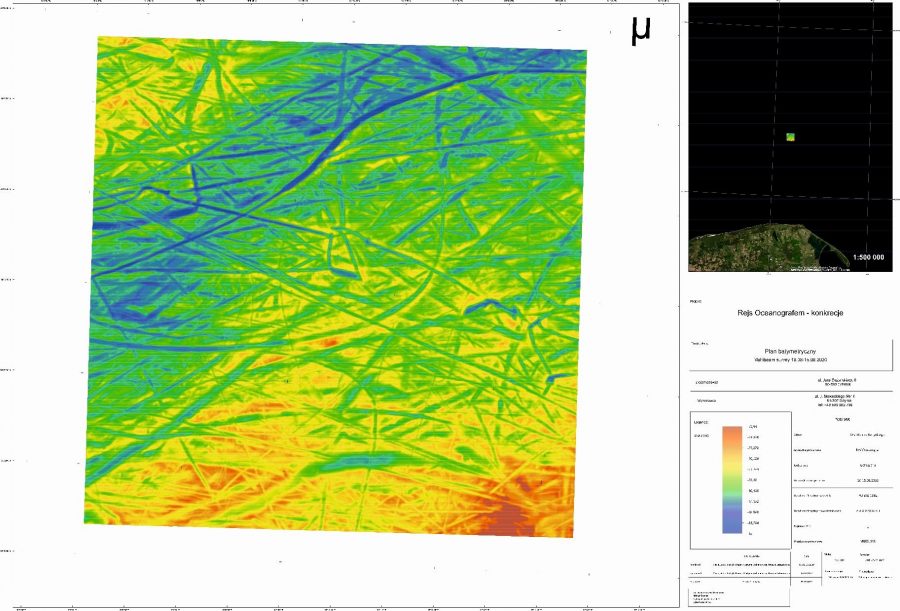On August 10-15 and September 22-25 this year. research cruises were held on the University of Gdańsk ship r/v “Oceanograf” as part of scientific cooperation between the Institute of Oceanography of the University of Gdańsk and the Polish Geological Institute. The initiators of the cooperation were dr hab. Leszek Łęczyński prof. UG and prof. dr hab. Szymon Uścinowicz from the Marine Geology Department of the PGI-NRI.
The research from the r/v Oceanograf vessel was carried out on a 5×5 km test site located approx. 60 km north of Rozewie (Fig. 1). This region was designated on the basis of cartographic works carried out by OGM PGI-NRI in the 70s and 80s of the last century. At that time, the places of occurrence of Fe-Mn nodules were documented, while the scope of the works carried out at that time did not provide for the determination of nodule resources or detailed geochemical and mineralogical studies.

The aim of this year’s research was the preliminary recognition of the geological and environmental conditions and the resources of iron-manganese nodules in the area of the Gotland-Gdańsk Threshold. The first cruise was attended by dr hab. Leszek Łęczyński prof. UG and dr Urszula Pączek and mgr Lesław Mil from PGI-NRI. With the participation of “Geo Ingenieurservice Polska”, profiling was carried out using a multi-beam echo sounder and side sonar, as a result of which a high-resolution digital model of the bottom relief and a sonar mosaic reflecting the type and distribution of sediments on the bottom surface were obtained. A spectacular achievement is documenting, for the first time in Polish sea areas and for the second time in the Baltic Sea, traces of iceberg drift (Fig. 2) formed in the initial stage of development of the Baltic Sea, the phase of the Baltic Ice Lake, around 15-12 thousand years ago.

The second cruise was dedicated to collecting samples of sediments and Fe-Mn nodules. In the first stage of the voyage, samples were collected in a 1×1 km grid (1 station per 1 km2) using a box-corer collecting sediment with an intact structure from the bottom with an area of 600 cm2, and using a Van Veen scooper collecting sediment from the surface 1000 cm2. In this way, 50 samples of sediments and nodules were collected at 25 research stations. In the second stage of the cruise, in one of the squares with an area of 1 km2, samples of nodules were collected using the Van Veen dredge from 25 research stations in a grid every 200 m, and additionally 17 samples from elevations and bottom depressions along the designated bathymetric profile. Dr. hab. Leszek Łęczyński prof. UG and prof. Szymon Uścinowicz, Dr. Urszula Pączek and Dr. Karol Zglinicki from PGI-NRI, as well as Dr. hab. Pawel Bylina prof. PW from the Department of Spatial Management and Environmental Sciences of the Warsaw University of Technology and Michał Banaś, MSc from the Institute of Geological Sciences of the Polish Academy of Sciences in Krakow.
The collected, exceptionally abundant research material will soon be subjected to preliminary research, which will allow for the preparation of maps of the degree of bottom coverage with nodules and the determination of the dependence of nodule concentration on the bottom relief and type of sediments. Then, after identifying possible sources of financing, a project for detailed geochemical and mineralogical research will be prepared.
It should be emphasized that the ship’s operating costs were covered in full by the University of Gdańsk from the subsidy for the maintenance of scientific and research equipment, while the participation of PGI-NRI employees in the cruises was financed from the subsidy of the Ministry of Science and Higher Education (task 68.2701.2000.00.0).
Photos: Michał Banaś, Leszek Łęczyński, Urszula Pączek
Text: Szymon Uścinowicz
link TO THE ARTICLE: https://www.pgi.gov.pl/aktualnosci/display/12564-pig-pib-bada-konkrecje-baltyckie-2.html